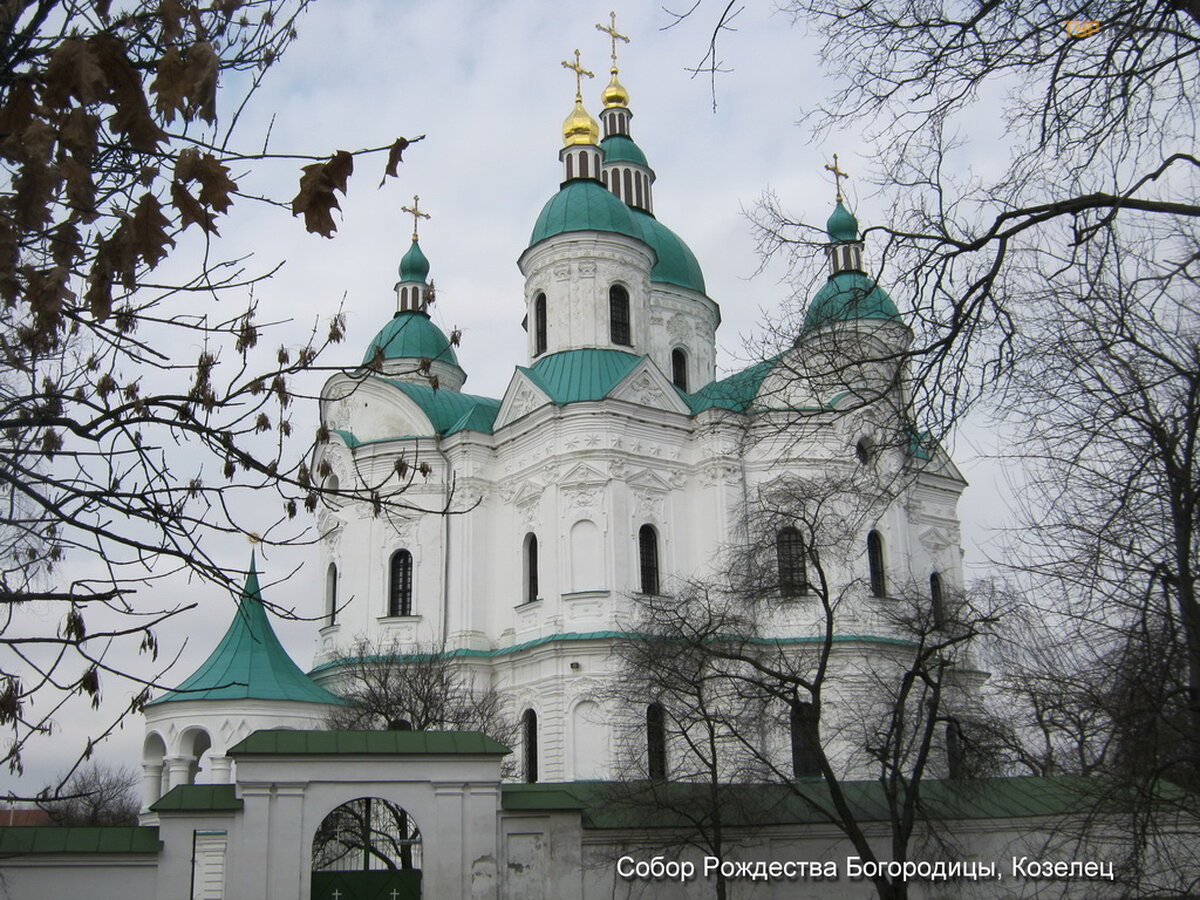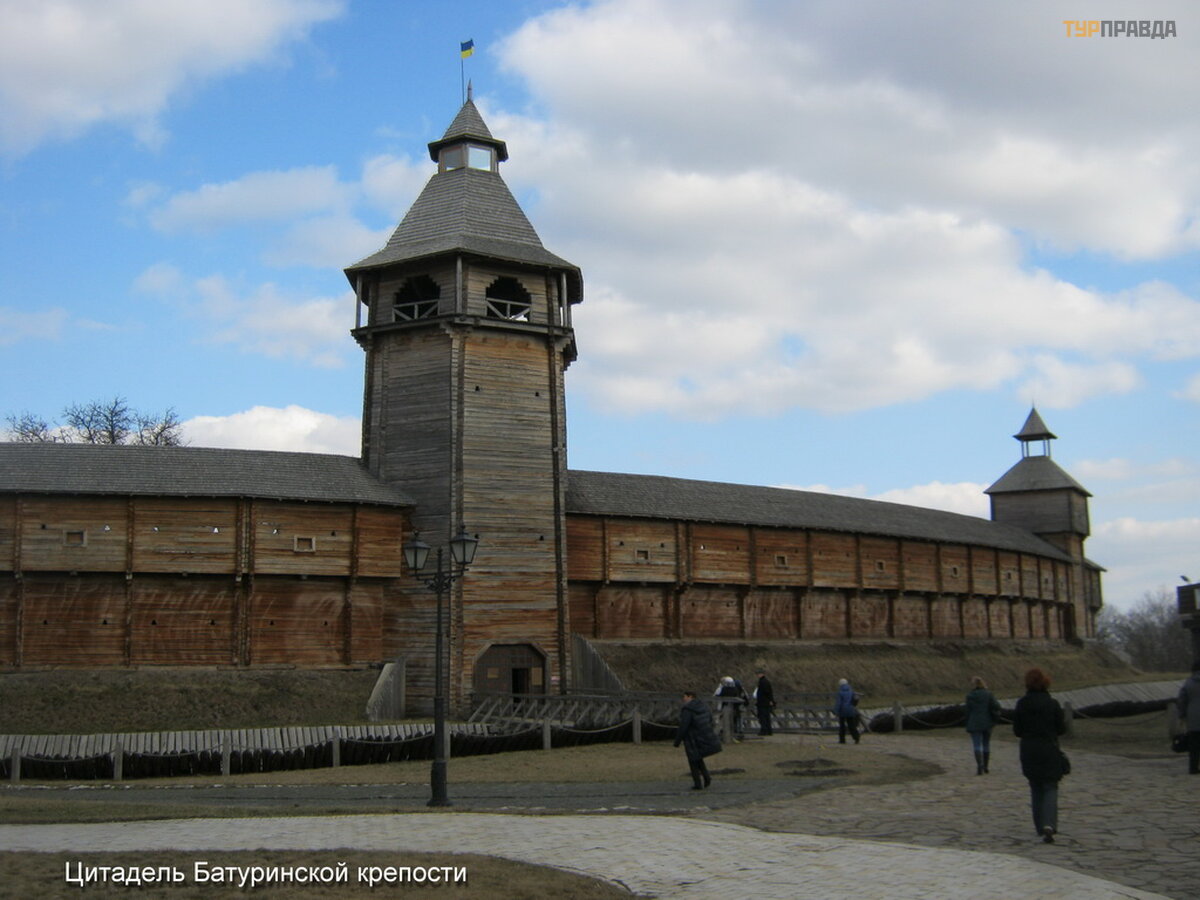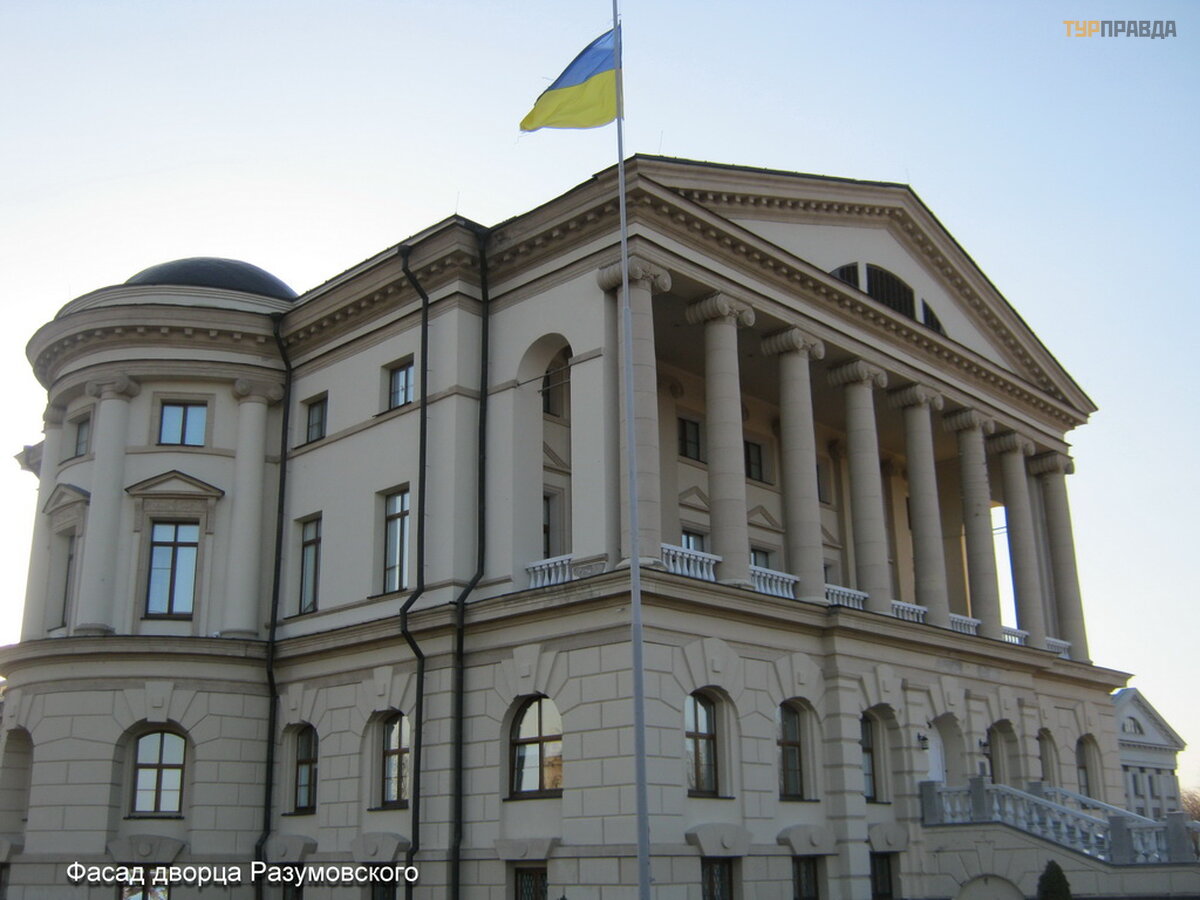The story of the trip Kozelets - Baturin
To writing a review about this trip, as, indeed, to the trip itself, I approached for a long time and thoroughly. In this case, it is impossible to get by with enthusiastic descriptions of your impressions, here was hidden the history of our country, its heroic pages, the tragedy of Baturin and his revival, so long veiled by Soviet history textbooks. Here you can not move away from history, otherwise the whole history will turn back.
So, March 15.2015, we can say the first sunny day, although very cool. Having missed traveling, after a long winter (honestly, we are not fans of traveling in winter), the very first tourists in the new season, we went with the Azhur company on a one-day trip to the Chernihiv region to the legendary city of Baturyn, the Hetman's capital of Ukraine.
The first stop on our way is a small town of Kozelets, in which only the Cathedral of the Nativity of the Virgin in the style of Ukrainian Baroque remained from historical attractions. It was built in 1752-1763. commissioned by Natalia Demyanovna Razumovsky ("Razumikha"), the mother of Kirill and Alexei Razumovsky.
The temple has a two-tiered structure and consists of a "summer" (upper) and "winter" or "warm" (lower) church, which is also the tomb of Natalia Razumovskaya. Here in Kozeltsa, the last hetman of Ukraine, Kirill Razumovsky, was born, whose brother Alexei was the favorite of Elizaveta Petrovna. Aleksey Razumovsky used his position and managed to get some indulgence for Ukraine from Elizabeth (for example, the restoration of the hetmanate, soon his brother Kirill was appointed hetman).
In the interior of the temple, the main detail is a multi-tiered wooden carved gilded iconostasis of the 18th century, created with the participation of the architect Bartolomeo Rastrelli.
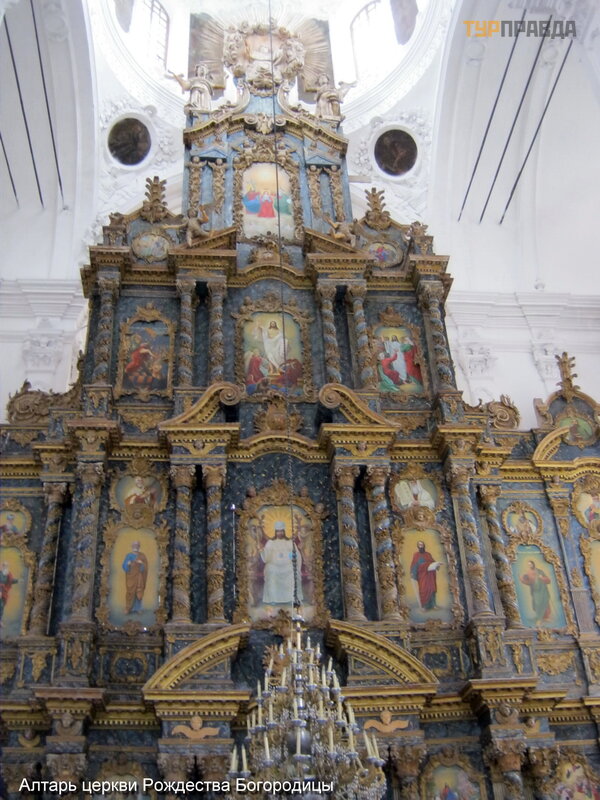 Altar in the Cathedral of the Nativity of the Virgin in Kozelets
Altar in the Cathedral of the Nativity of the Virgin in Kozelets
According to the accompanying guide, the iconostasis was made for the Smolny Monastery, where it fit perfectly in size. But Natalya Razumovskaya, almost a mother-in-law, begged Elizaveta Petrovna for this iconostasis for the cathedral in Kozeltsa, and mother-in-law, as you know, does not refuse. Since the iconostasis turned out to be much larger, it was dismantled into pieces. And those parts of the iconostasis that did not fit in the cathedral in Kozelts were transported and mounted in an ordinary rural church on the Razumovsky estate not far from Kozelts. However, there are quite a few versions of how such an iconostasis appeared in such a town, we were told this. It is impossible to check whether parts of that iconostasis exist, because the church burned down.
We inspect the lower church (Sunday, there is a morning service), our guide persuades the minister to allow us to inspect the iconostasis in the upper church. It is indeed cold, but the beauty and grandeur of the iconostasis are amazing! The 27-meter azure giant does not fit into the lenses of any of the cameras on any side. Unfortunately, there is little time for its detailed study.
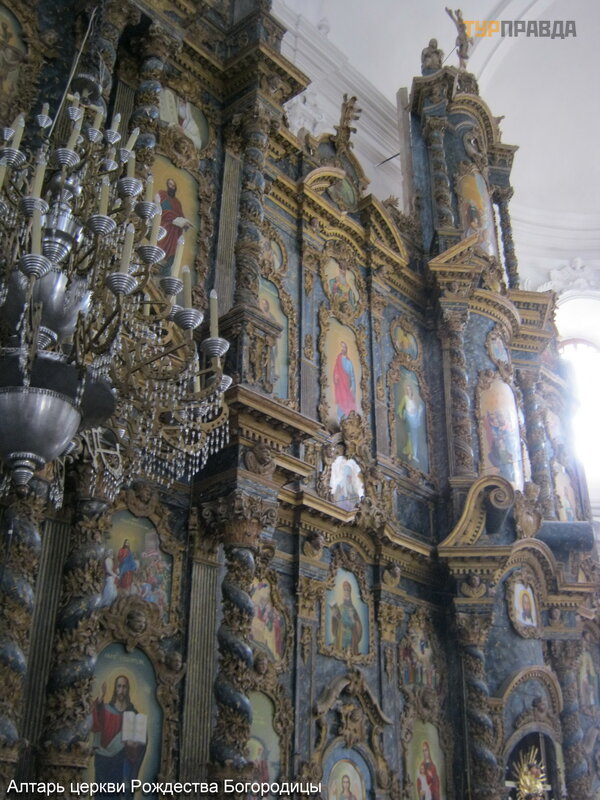 Altar in the Cathedral of the Nativity of the Virgin in Kozelets
Altar in the Cathedral of the Nativity of the Virgin in Kozelets
So, the first tourist attraction in Baturyn is the house of Judge Kochubey.
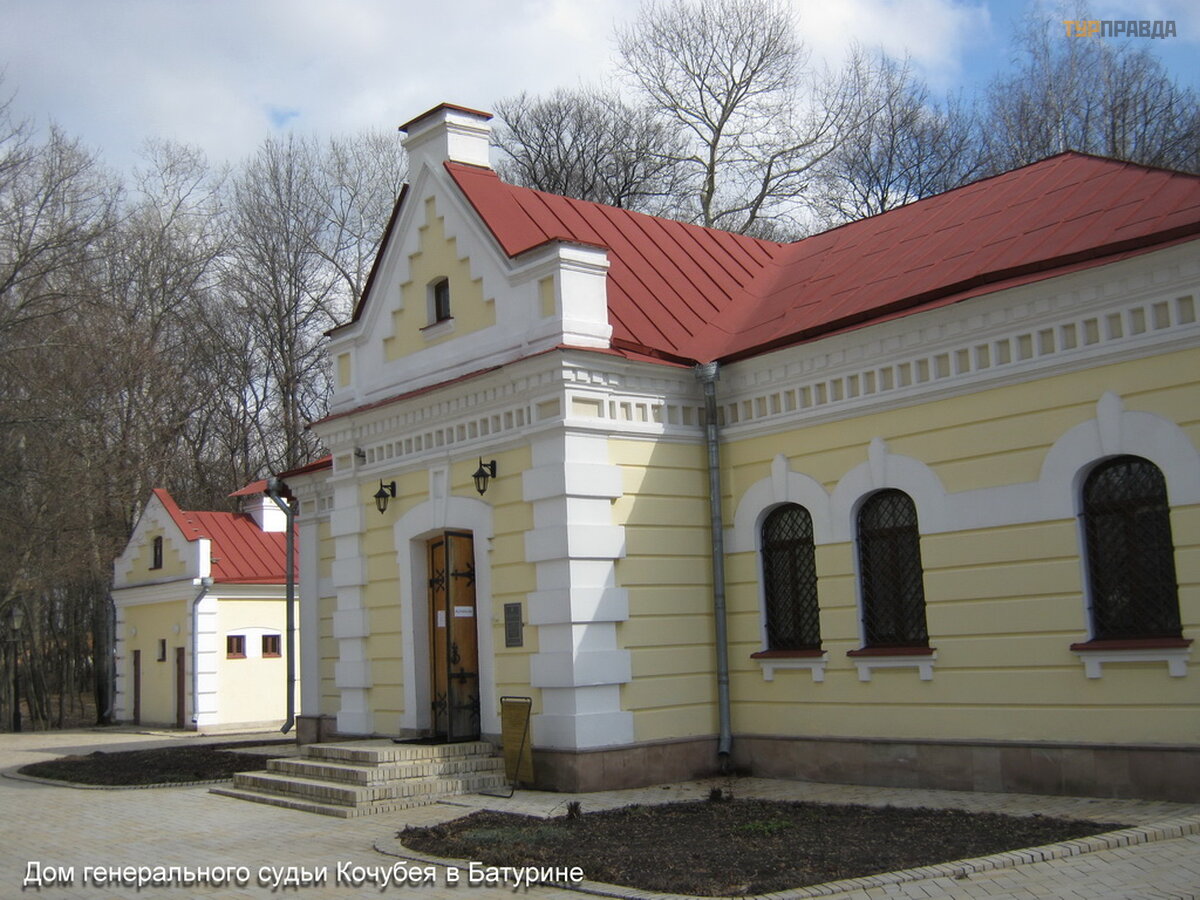 House of Judge V. Kochubey, Baturin
House of Judge V. Kochubey, Baturin
Around the house there is a beautiful park of the former estate and a small restored wooden chapel (although I prefer the name "chapel") of St. Nicholas the Wonderworker
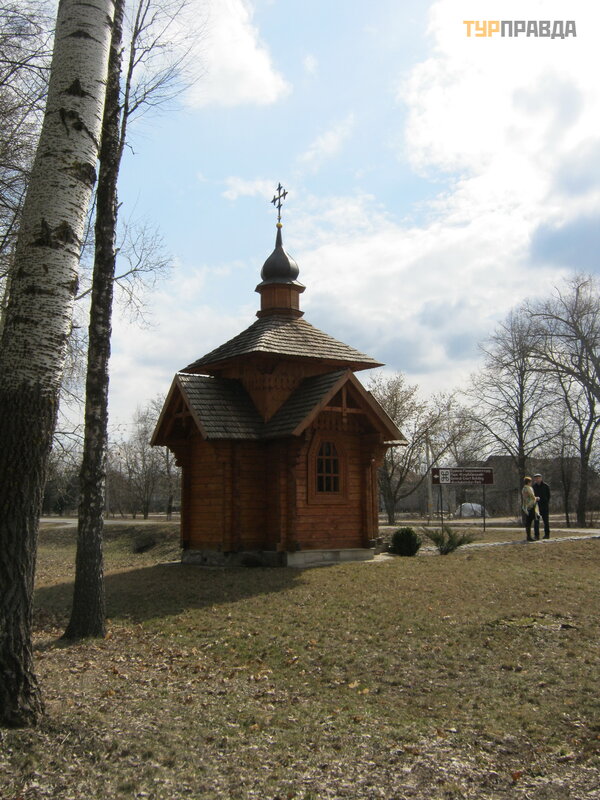 Caplic of Nicholas the Wonderworker, Baturin
Caplic of Nicholas the Wonderworker, Baturin
with amazing icons
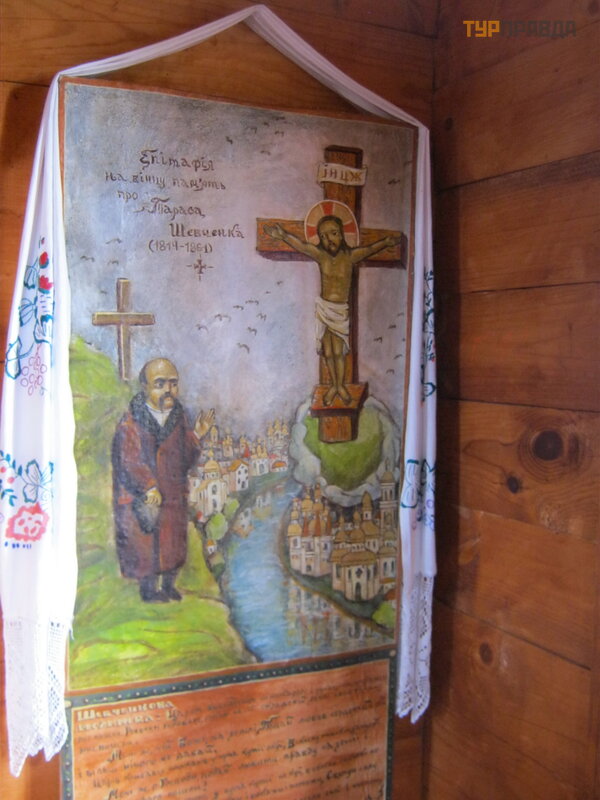 The icon in the chapel of St. Nicholas the Wonderworker, Baturin
The icon in the chapel of St. Nicholas the Wonderworker, Baturin
and a carved sculpture of Nicholas the Wonderworker himself.
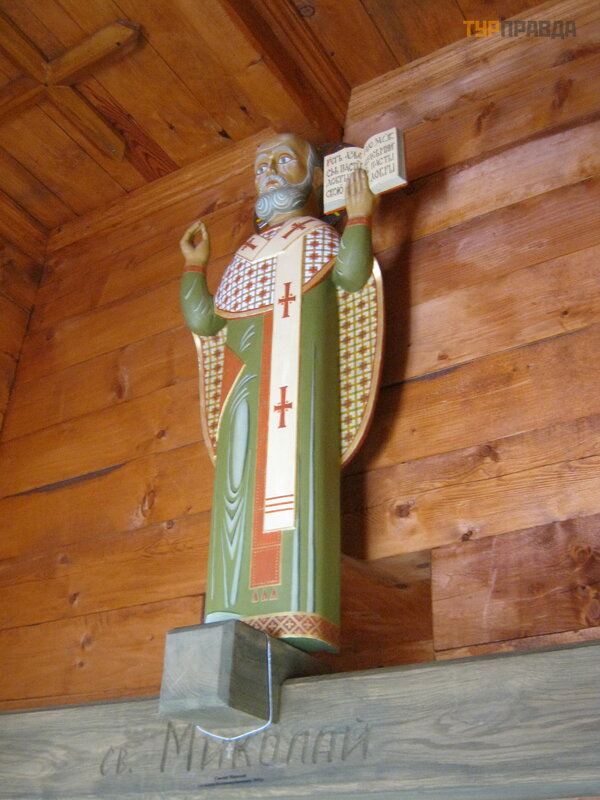 Wooden sculpture of Nicholas the Wonderworker in a chapel, Baturin
Wooden sculpture of Nicholas the Wonderworker in a chapel, Baturin
The House-Museum of Vasily Kochubey, Judge General of the Zaporozhian Army, is the only building in Baturyn that has survived from the time of the Baturyn tragedy. The one-story house of the General Court was built in the middle of the 17th century.
Since 1700, Vasily Kochubey lived here with his family. The interior has a well-preserved azure stove
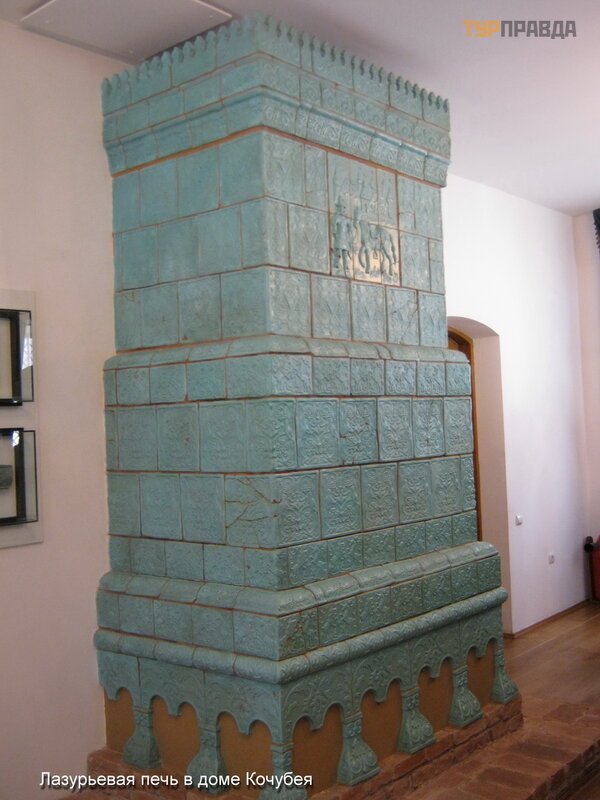 Azure stove in Kochubey's house in Baturin
Azure stove in Kochubey's house in Baturin
with antique tiles,
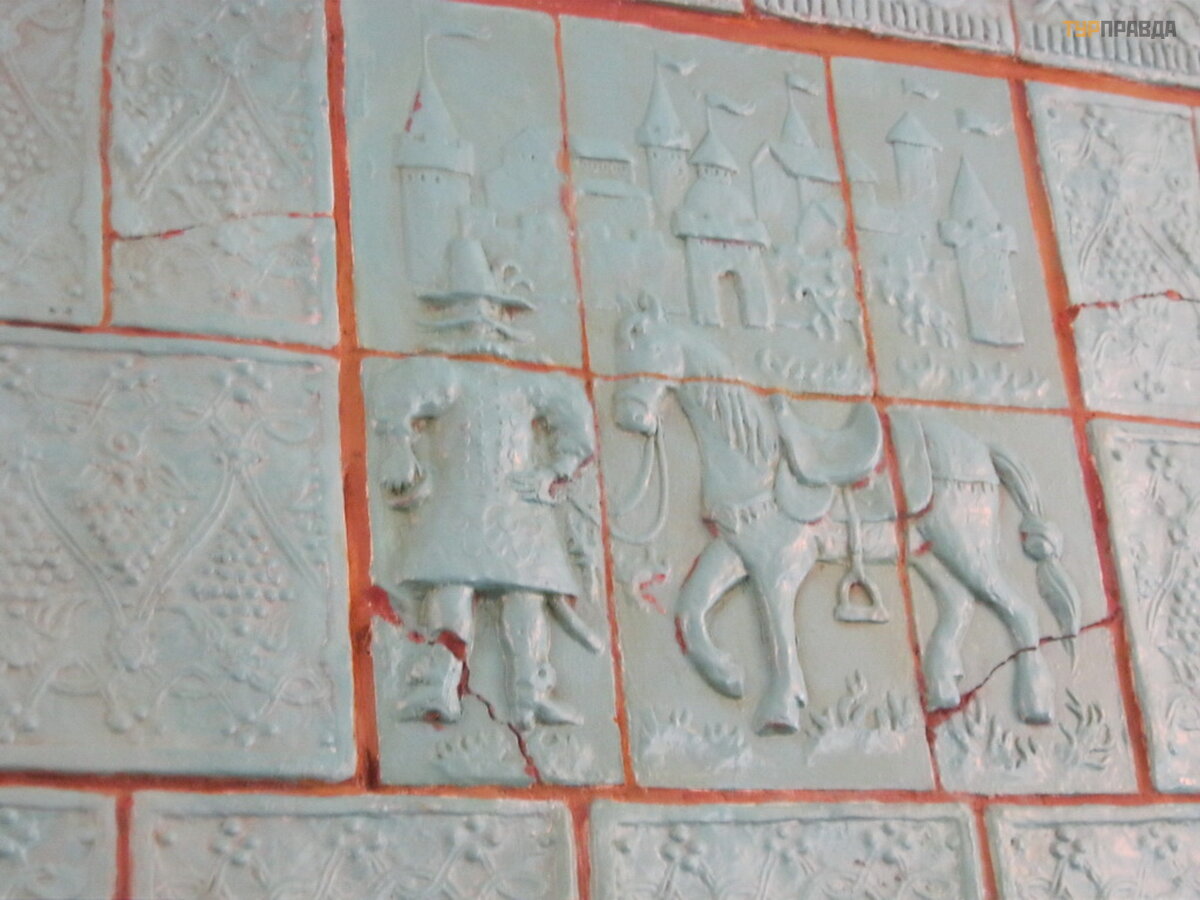 Antique tiles on the stove in Kochubey's house, Baturin
Antique tiles on the stove in Kochubey's house, Baturin
there is an exhibition of locks and keys (amazing in size).
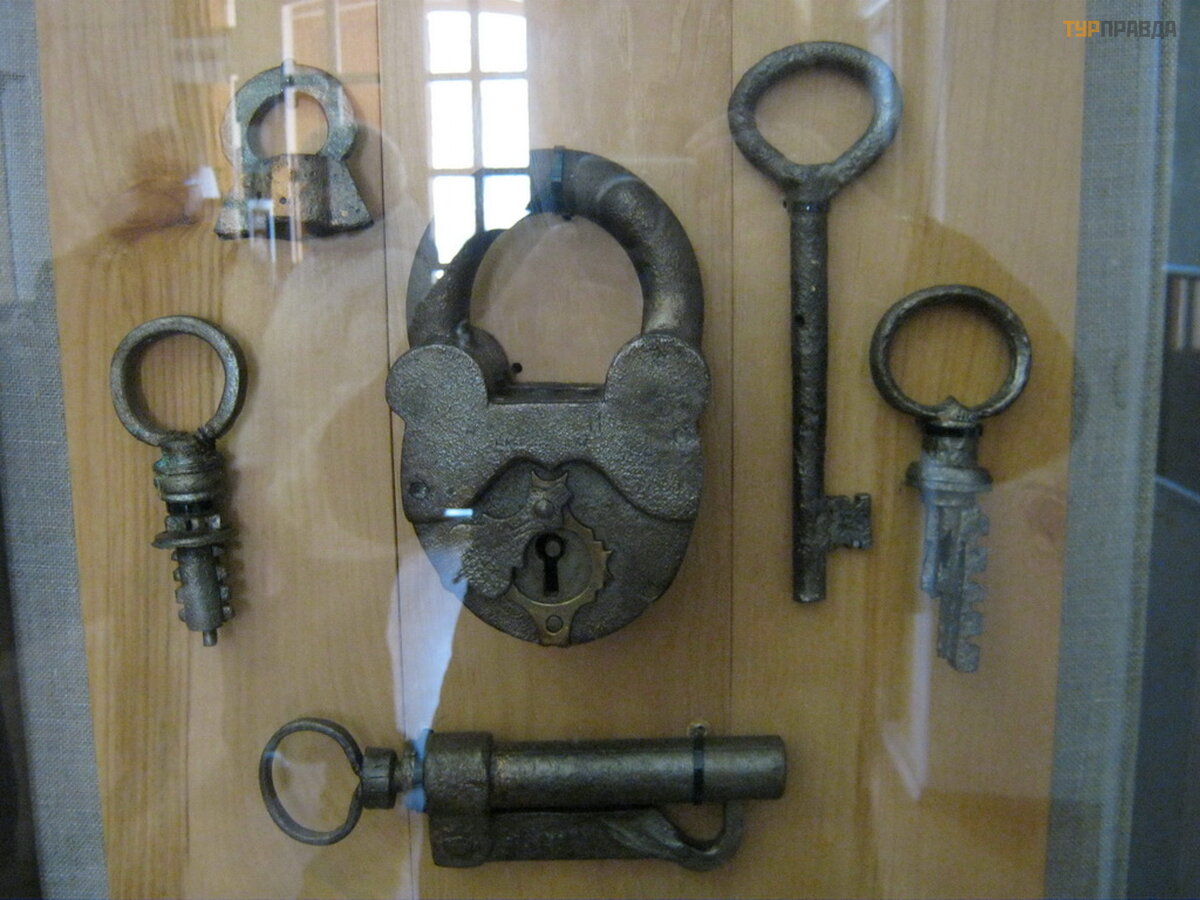 Locks and keys in the house of Kochubey in Baturin
Locks and keys in the house of Kochubey in Baturin
On the ground floor of the building there were courtrooms, and in the basement there was a prison with a torture room.
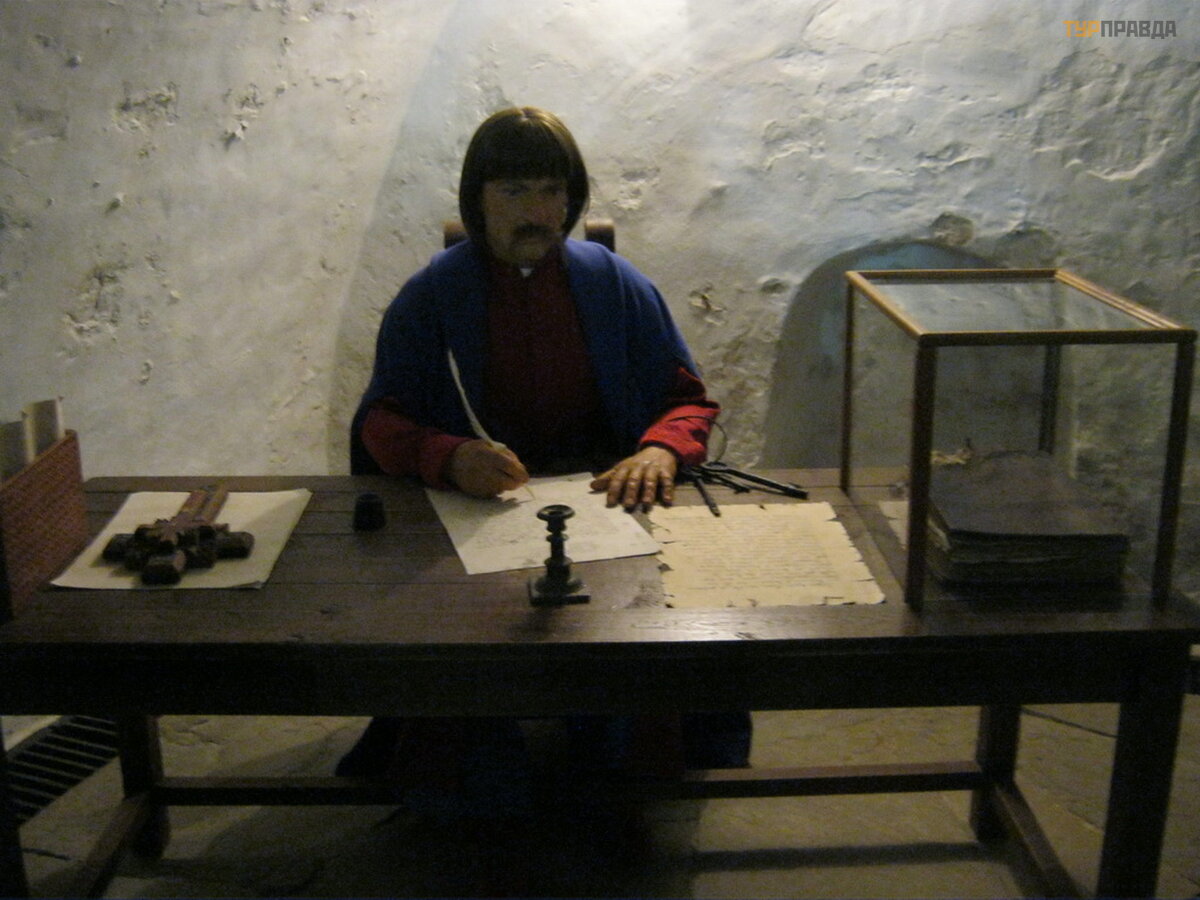 Wax figure of a clerk in the prison building of Kochubey's house, Baturin
Wax figure of a clerk in the prison building of Kochubey's house, Baturin
Now in the basement there is an exposition with two wax figures of a clerk and a prisoner, as well as various instruments of torture of those times.
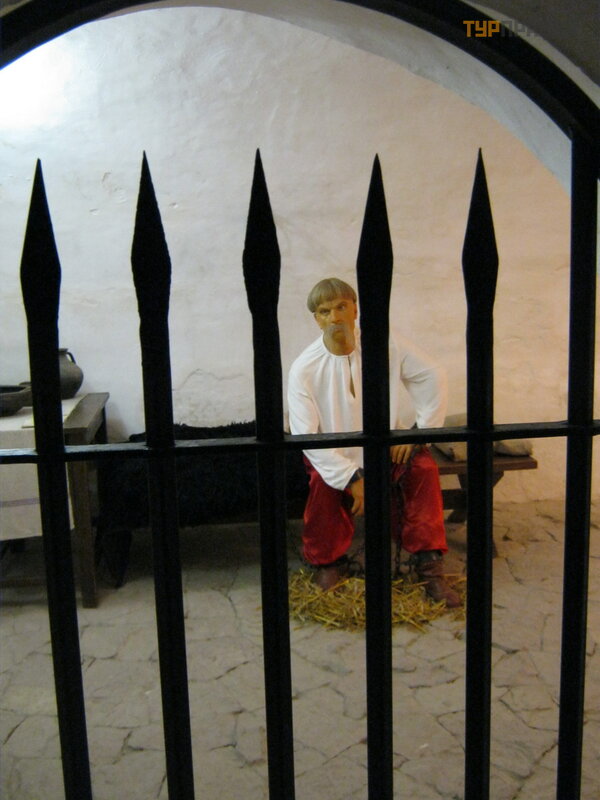 The wax figure of a prisoner in the house of Kochubey, Baturin
The wax figure of a prisoner in the house of Kochubey, Baturin
Since 1975, the Kochubey house has housed the local history museum, which in 2006 became part of the Hetman's Capital National Historical and Cultural Reserve.
16-year-old daughter of Kochubey Motrya
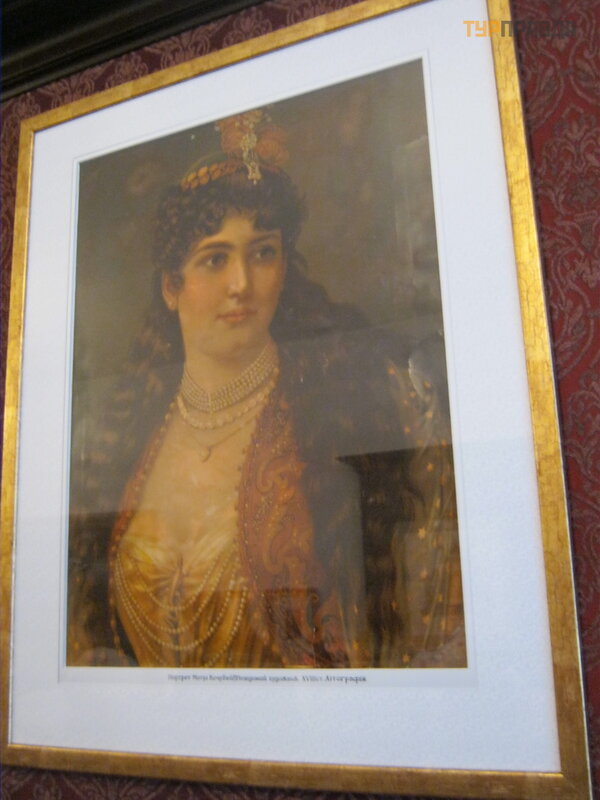 Portrait of Motri Kochubey in Kochubey's house, Baturin
Portrait of Motri Kochubey in Kochubey's house, Baturin
I was in love with my godfather, 58-year-old Hetman Ivan Mazepa.
The love of Motry and Ivan Mazepa is dedicated to a separate hall, in the center of which there is a glass rack with copies of the love letters of the hetman to Motry. All his letters begin with such tender words-addresses: "My heart", "My heart is kohan".
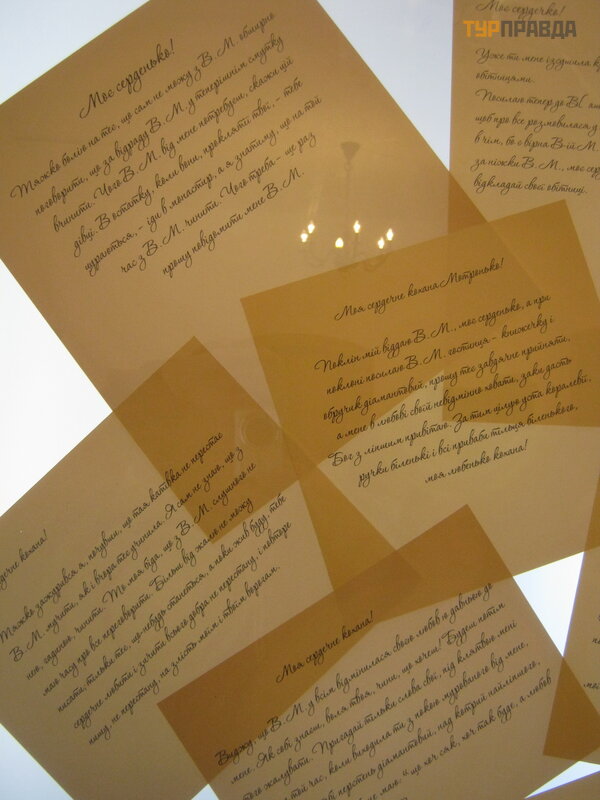 Copies of Hetman Ivan Mazepa's letters to his beloved Motra Kochubey
Copies of Hetman Ivan Mazepa's letters to his beloved Motra Kochubey
There is a monument to the oak in the park, the hollow of which served as a mailbox in this love correspondence. When Mazepa came to ask for the hand of Motrya from Vasily Kochubey, he was refused, because Motrya was not only younger than Mazepa, but also was his goddaughter, so according to church canons she could not become his wife. The father was categorically against their marriage. However, Motria voluntarily fled to Mazepa and for some time (it is not known for certain how long) lived in his house. Although the hetman sent Motrya home to his parents, Kochubey and his associate Ivan Iskra tried to settle scores with Mazepa by informing the Russian Tsar Peter I about the hetman's secret negotiations with the Swedish king Charles XII. But the report was deemed false in the light of the well-known personal enmity between Kochubey and Mazepa. The tsarist government handed over the scammers to Mazepa, and they were convicted. After the execution of her father, Motrya went to the monastery.
After visiting the house of Kochubey, we go to the next object - the citadel of Baturin.
The Citadelis a reproduction of a Cossack fortress on a full scale, on the high bank of the Seim River, with deep defensive ditches
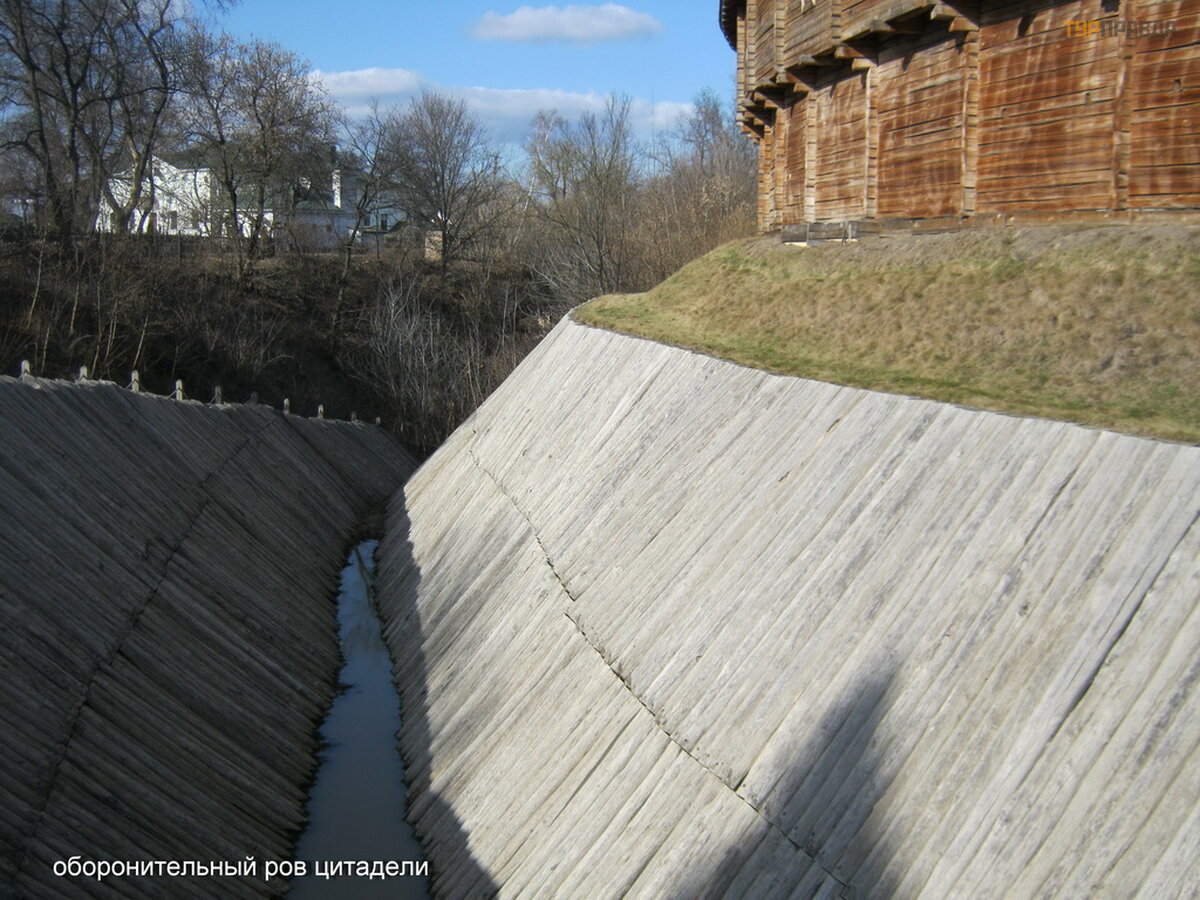 Defense ditches of the citadel
Defense ditches of the citadel
and with the hetman's house in the center. The fortress is completely wooden. In the 17-18 century, artillery reached such heights that it destroyed any stone fortifications. And an ordinary tree, smeared with clay, gave a ricochet from cannonballs and artillery bombs.
And the house of Hetman Mazepa is brick,
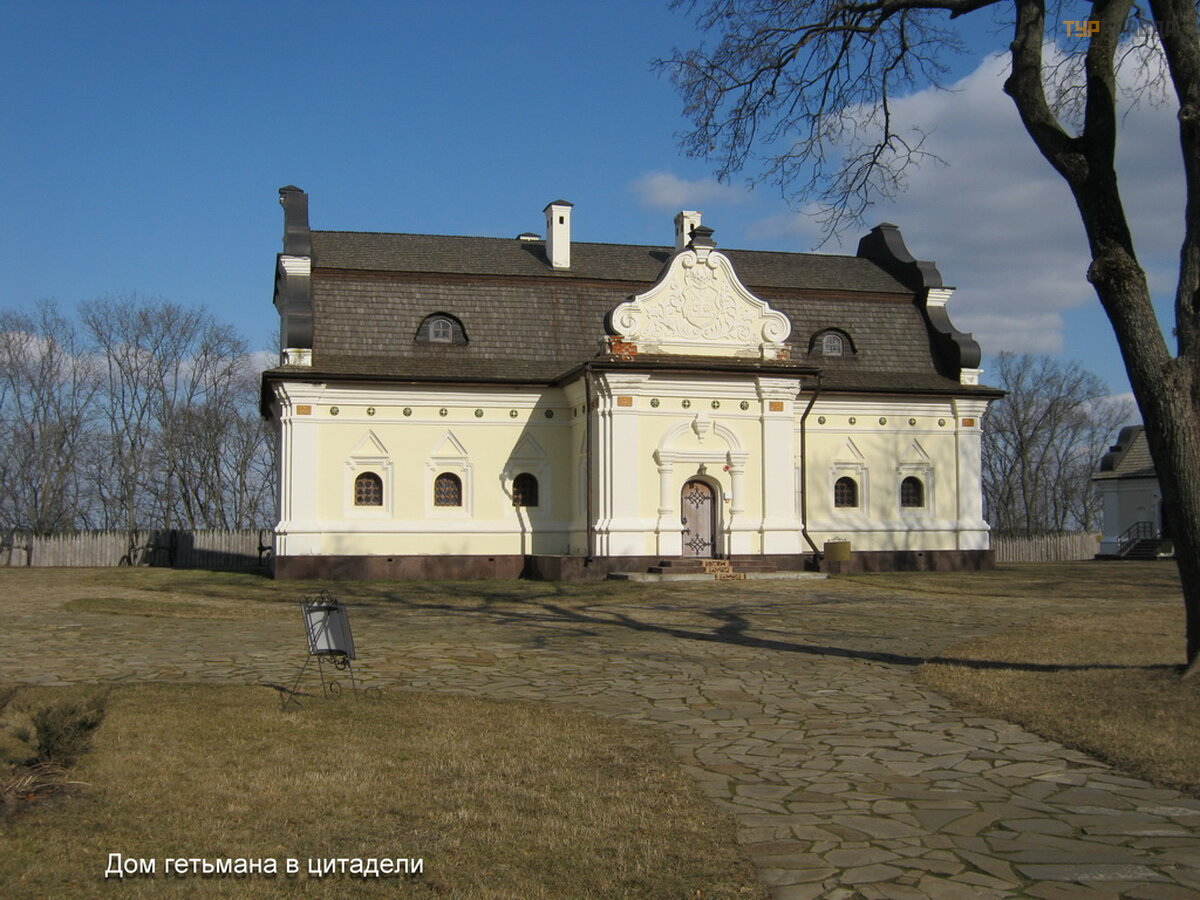 Hetman Mazepa's house on the territory of the citadel, Baturin
Hetman Mazepa's house on the territory of the citadel, Baturin
with coat of arms on the pediment.
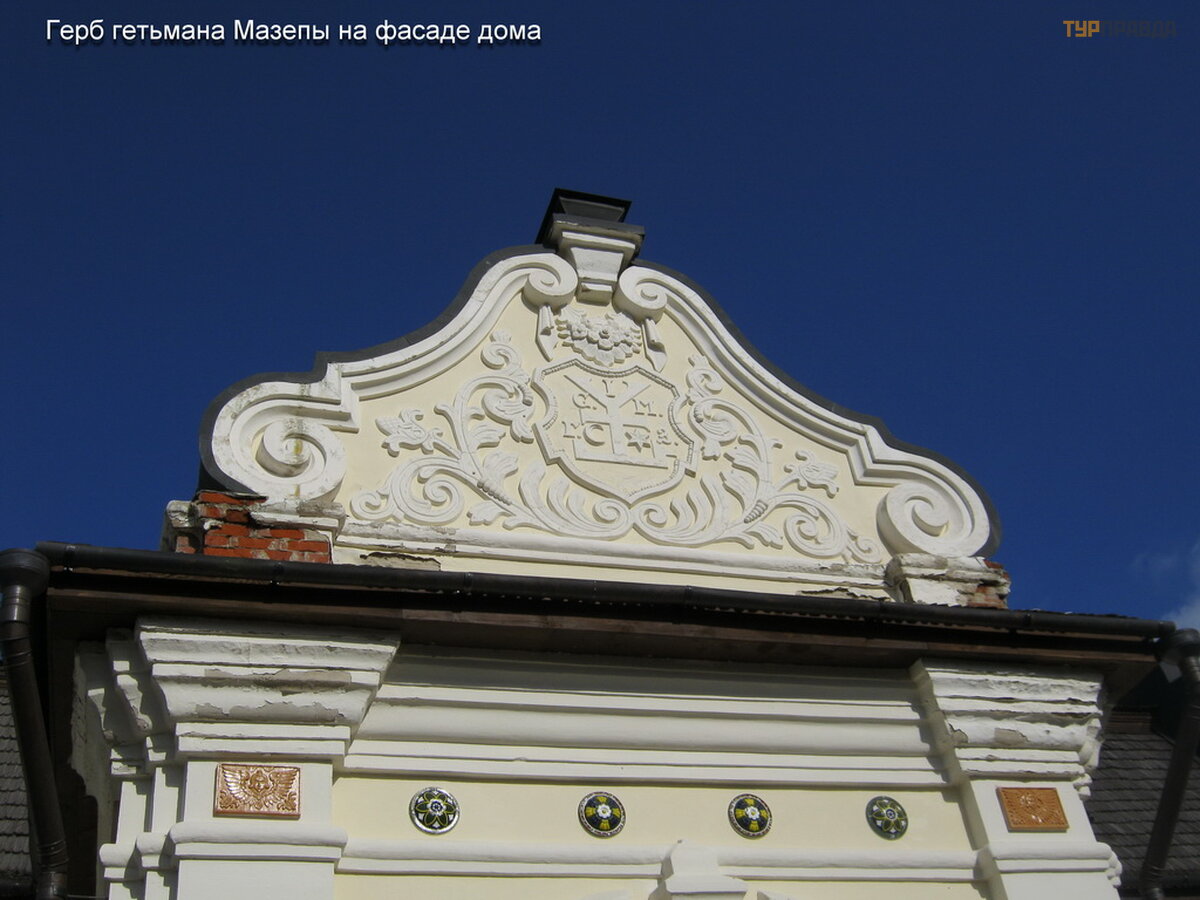 Mazepa's coat of arms on the pediment of the hetman's house in the citadel
Mazepa's coat of arms on the pediment of the hetman's house in the citadel
There is also a Cossack wooden church on the territory of the citadel, where services are held.
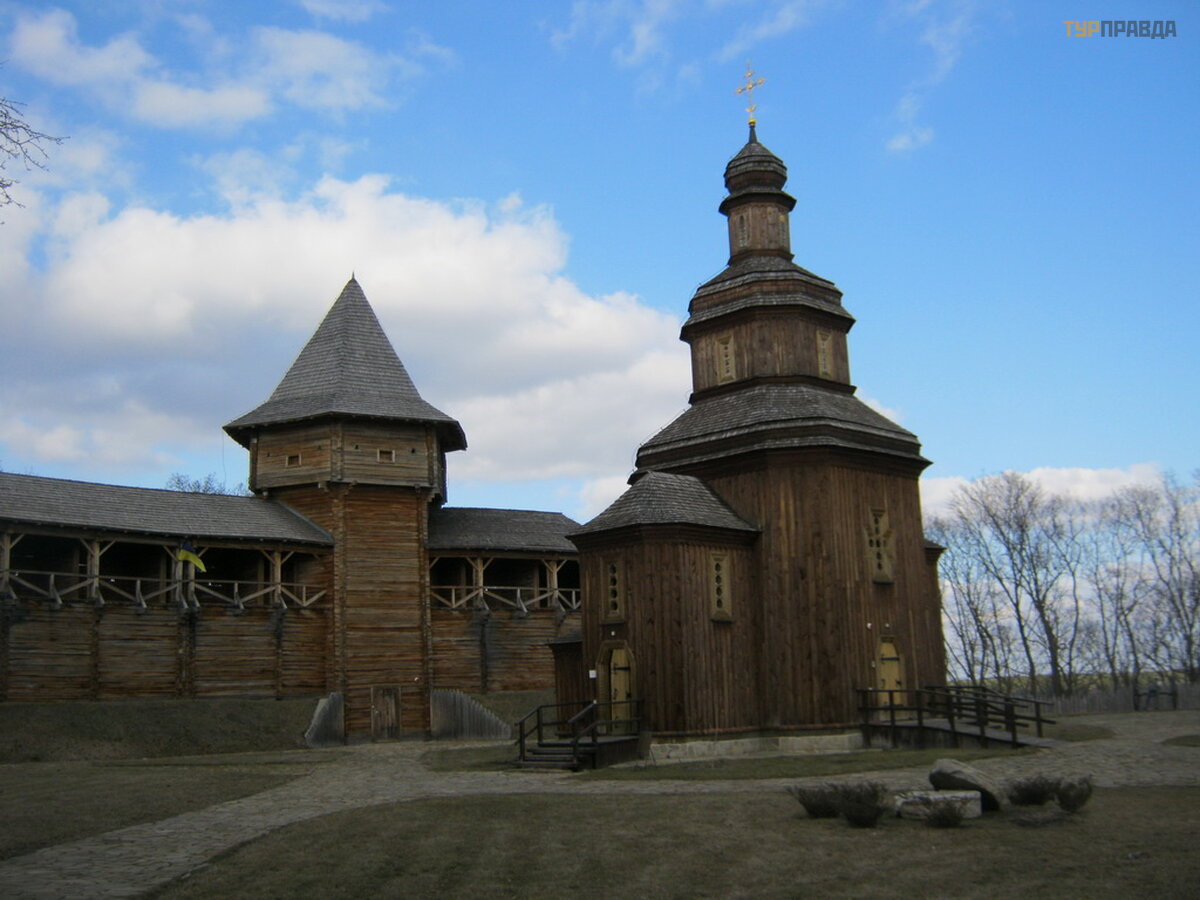 Wooden Cossack church on the territory of the citadel, Baturin
Wooden Cossack church on the territory of the citadel, Baturin
There is also an exposition of guns used to defend the citadel.
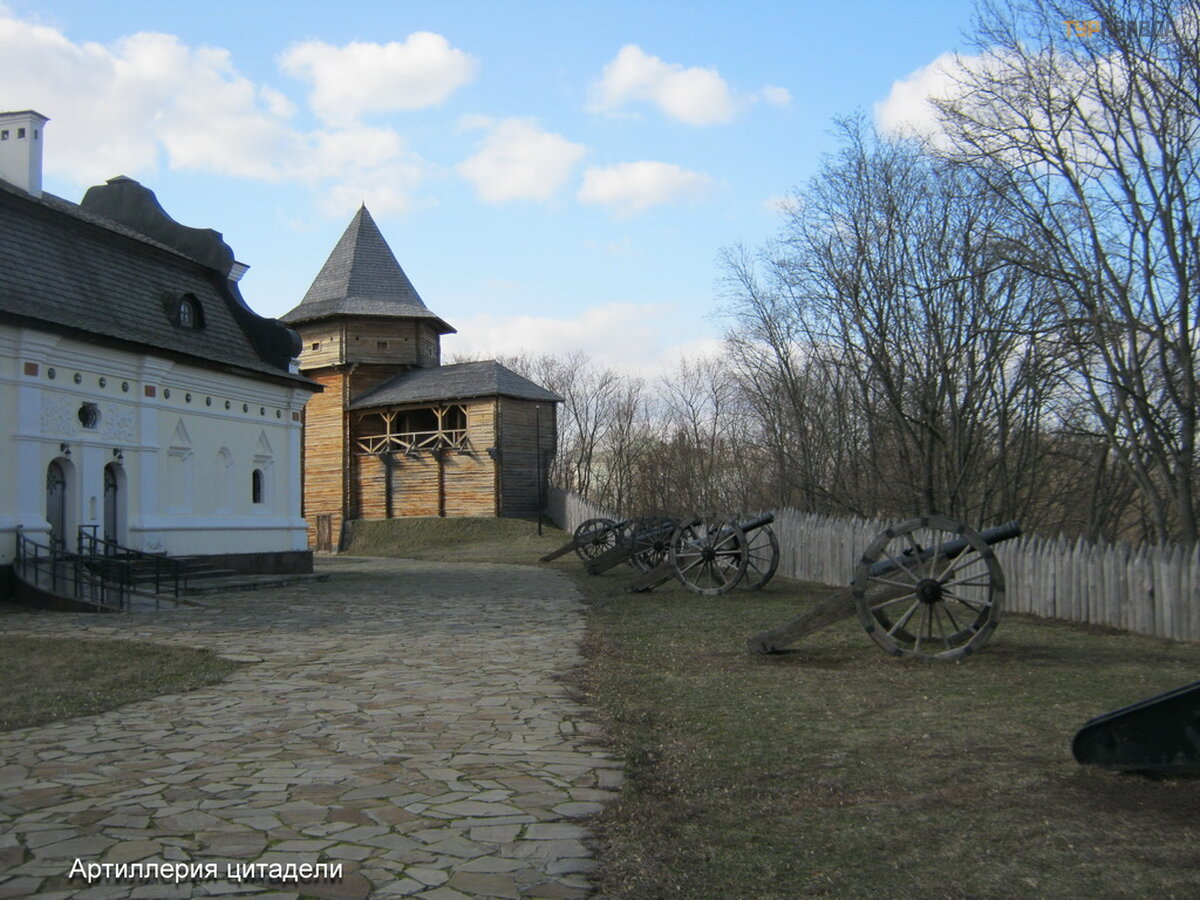 Cannons to defend the Baturin citadel
Cannons to defend the Baturin citadel
And now a quote from Wikipedia, because it is difficult to describe it in your own words, and I would not want to include emotions.
In 1708, Hetman Mazepa decides that the moment has come to break with Moscow. After the unification of Mazepa with Charles XII, the Russian Tsar Peter I orders Menshikov to immediately capture Baturin. The castle was well fortified, there was a significant Cossack garrison in it. Courageously defended by Colonel Dmitry Chechel and armored captain (inspector of the Cossack artillery) Friedrich Kö nigsek, Baturin was nevertheless taken by Menshikov on November 2.1708: the betrayal of the Prilutsk colonel Ivan Nos helped Menshikov take the citadel. Breaking into Baturyn, the Russian troops took possession of the hetman's treasury, artillery, food supplies and put to painful death not only the defenders of the city, but almost the entire civilian population.
“Baturin held out for several days, but even that Muscovite took and defeated him. The faithful Chechel, a colonel over the Serdyuks (guardsmen), was also taken. The entire capital of Mazepa was destroyed and burned - no stone was left unturned. How fierce the Muscovites were over the luxurious palace of the hetman, over all his belongings and servants! (. . . ) “Zhinochek and little ones” - the servants of the hetman who remained in the Baturinsky palace and castle - were thrown into the Seim and drowned! - wrote, based on Cossack chronicles, European newspapers and family traditions, historian D. L. Mordovtsev.
“Baturin was taken, its defenders were exterminated. ” — the Russian Big Encyclopedia (edited by S. N. Yuzhakov) recorded in the early years of the 20th century.
Civil and fortification buildings, churches, monasteries - everything was destroyed. The massacre of citizens, as the excavations currently underway in Baturyn have shown, was committed near the hetman's palace and the houses of the Cossack elders.
According to preliminary data, from 5 to 15 thousand people were killed. Baturin was wiped off the face of the earth. In memory of those who died in the Baturin tragedy, a memorial stone cross was erected on the territory of the citadel.
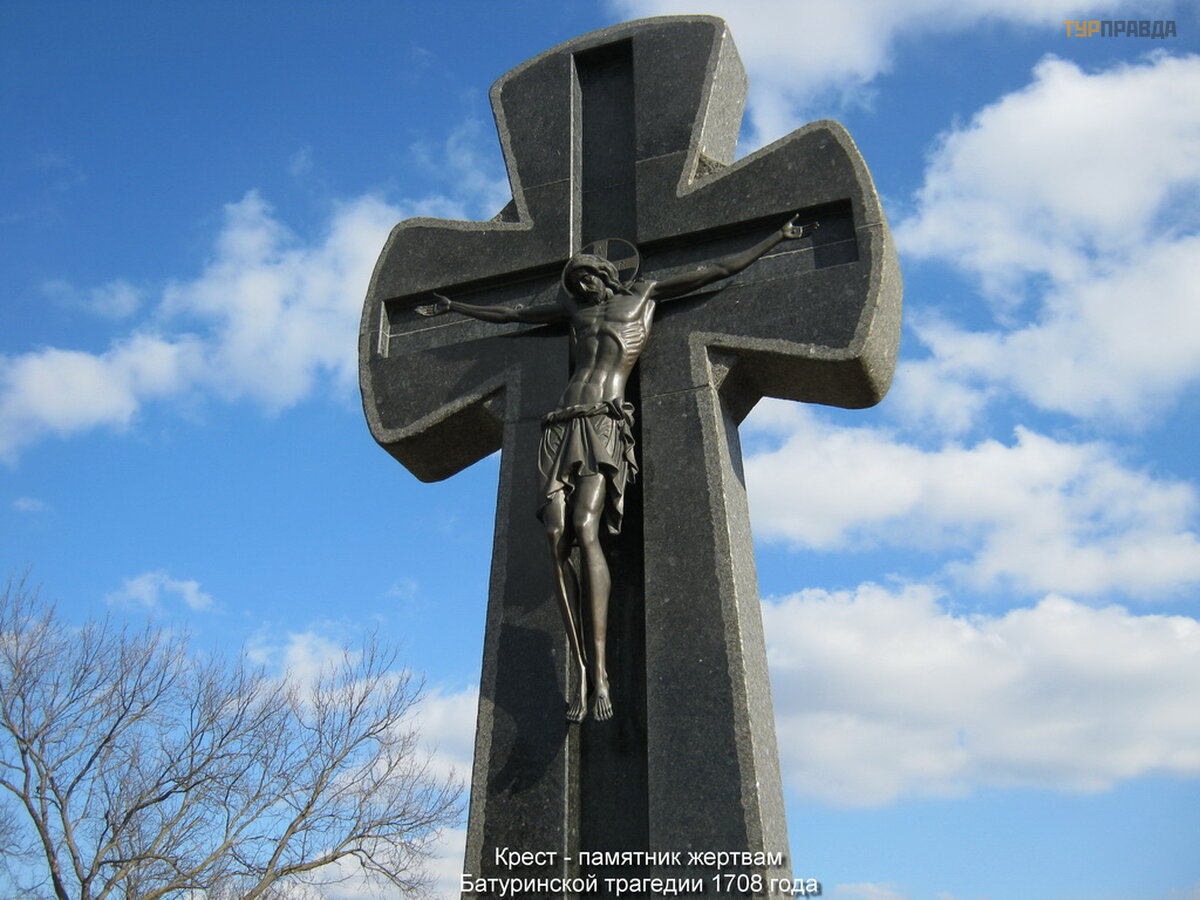 The cross-monument to the victims of the Baturin tragedy of 1708
The cross-monument to the victims of the Baturin tragedy of 1708
The devastated city remained deserted for a long time, but an attempt to revive Baturyn was made by hetman Kirill Razumovsky, who founded his baroque palace here. In 1750, Kirill Razumovsky again proclaimed Baturyn the capital of the Hetmanate. Razumovsky began the construction of a grandiose palace and the arrangement of the park,
 Kkiril Razumovsky's Palace, Baturin
Kkiril Razumovsky's Palace, Baturin
but did not wait for the completion of construction - he suddenly died.
The engraving from the book “Description of the Glorious and Great Provincial Cities of the All-Russian Empire” printed around that time shows Baturin City in the country of Cherkasy. . A strong wall (with at least three towers), a palace, a church and two mosques appear before our eyes... Thus, the Cossack life was revived on a pogrom and ruined place…
Near the citadel is the Church of the Resurrection,
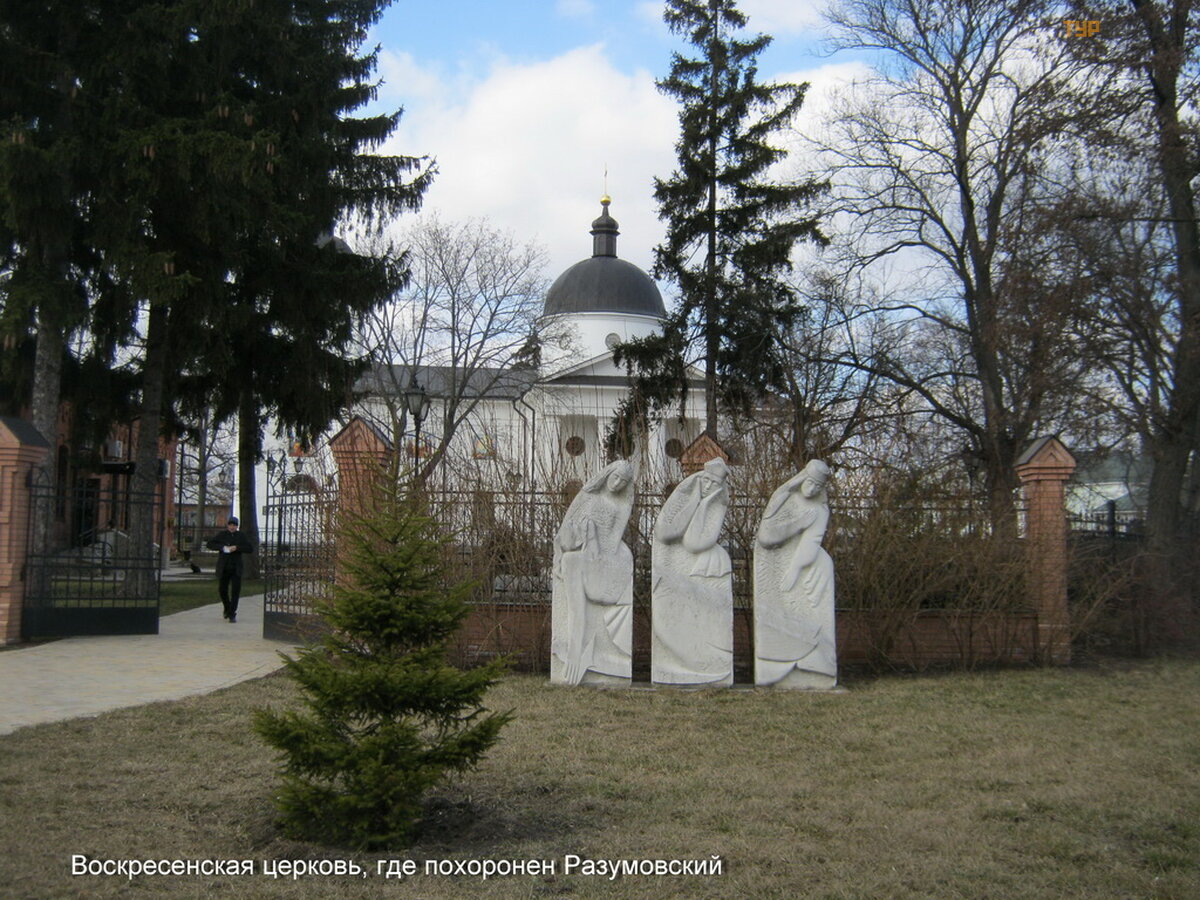 Resurrection Church in Baturin
Resurrection Church in Baturin
built in 1803 by Hetman Kirill Razumovsky, according to legend, from the bricks of the destroyed bell tower of the Mazepa Trinity Cathedral. It contains a crypt with the body of Razumovsky, who died in the year the temple was built.
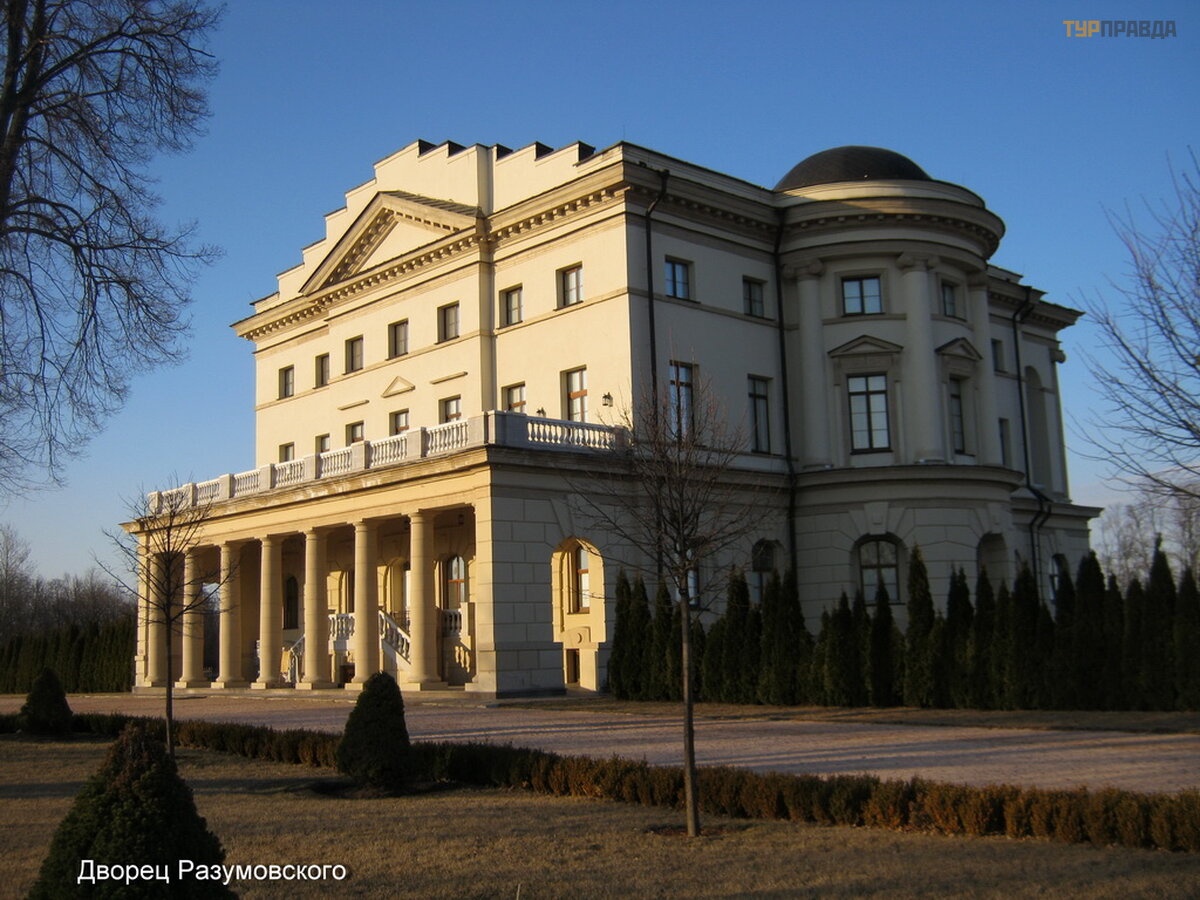 Central entrance to the Razumovsky Palace, Baturin
Central entrance to the Razumovsky Palace, Baturin
The palace has been completely restored. A great job has been done. Now it is a palace and park ensemble on the banks of the Seim River. In Soviet times, it was destroyed, survived the fire, so almost only 2 walls remained from it.
The palace never received its owner. In 1803, when construction and finishing work was almost completed, Count Razumovsky died suddenly. According to the plan of the deceased, the palace was supposed to become the residence of the Ukrainian hetmans, but this was not destined to come true - immediately after the death of Kyrylo Razumovsky, the position of hetman was abolished.
For the children of Razumovsky, accustomed to life in the capital, the estate in the provincial Baturin turned out to be unnecessary, and the palace actually remained ownerless. For almost a century, almost no one was engaged in it, and by the beginning of the twentieth century, decline and desolation reigned in the palace.
*
In the 1930s, two outbuildings built at the palace were destroyed, and over time, the palace itself began to be dismantled for building materials. By 1955, only the walls remained from the palace, without a roof and ceilings.
The Razumovsky Palace acquired its current appearance during the large-scale restoration work carried out from 2003 to 2009. The grand opening of the palace took place on the eve of the Independence Day of Ukraine, August 22.2009.
At present, in the luxurious halls of the palace there is an exposition dedicated to the Razumovsky family and everything connected with this surname. The interiors are beautiful,
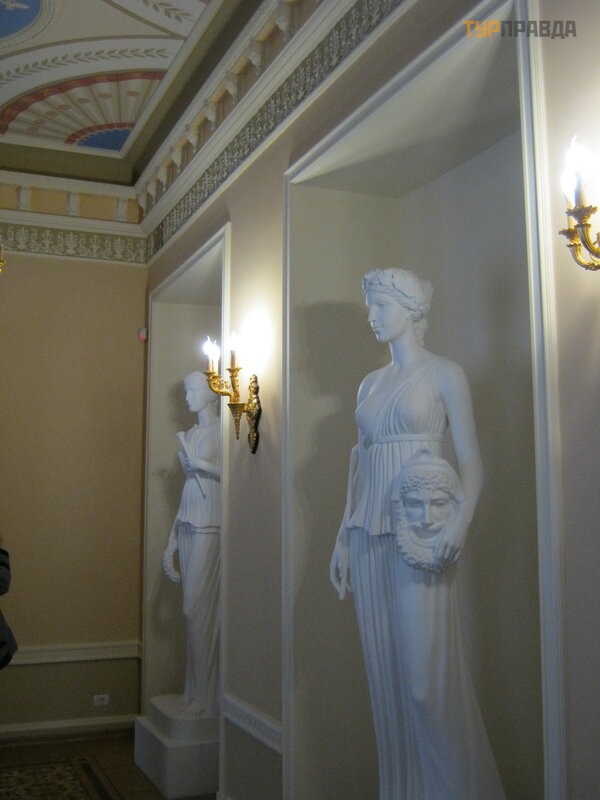 Muses in the interiors of the Razumovsky Palace in Baturin
Muses in the interiors of the Razumovsky Palace in Baturin
luxurious,
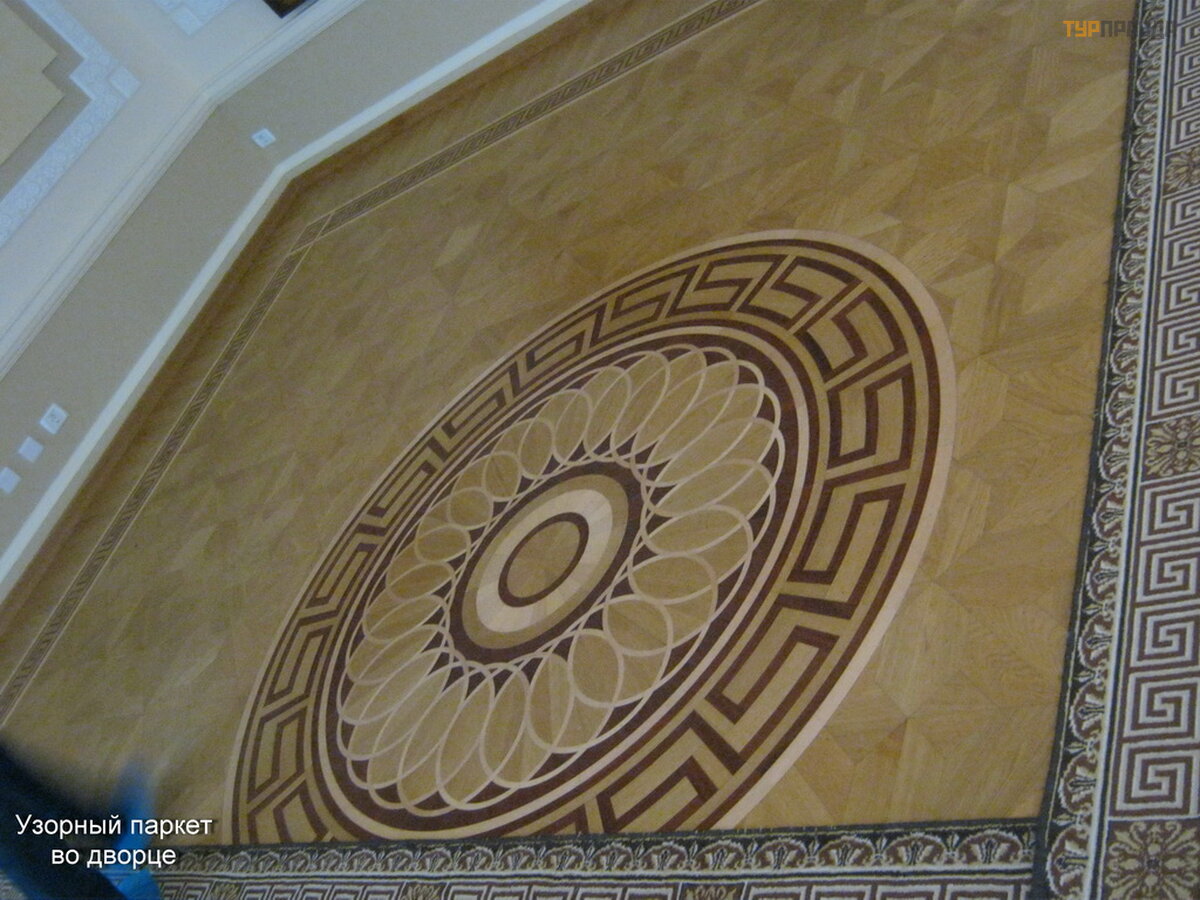 Parquet in one of the halls of the Razumovsky Palace, Baturin
Parquet in one of the halls of the Razumovsky Palace, Baturin
but some "modern" ones. There is no that old spirit.
 Chandelier in the Razumovsky Palace, Baturin
Chandelier in the Razumovsky Palace, Baturin
The central part of the exposition is the Hetman's Hall, where the saber of Kirill Razumovsky (a gift to the museum from his descendants) is exhibited
 Hetman Razumovsky's saber, Baturin
Hetman Razumovsky's saber, Baturin
and a table "Stone" with a marble board inlaid with semi-precious Ural stones.
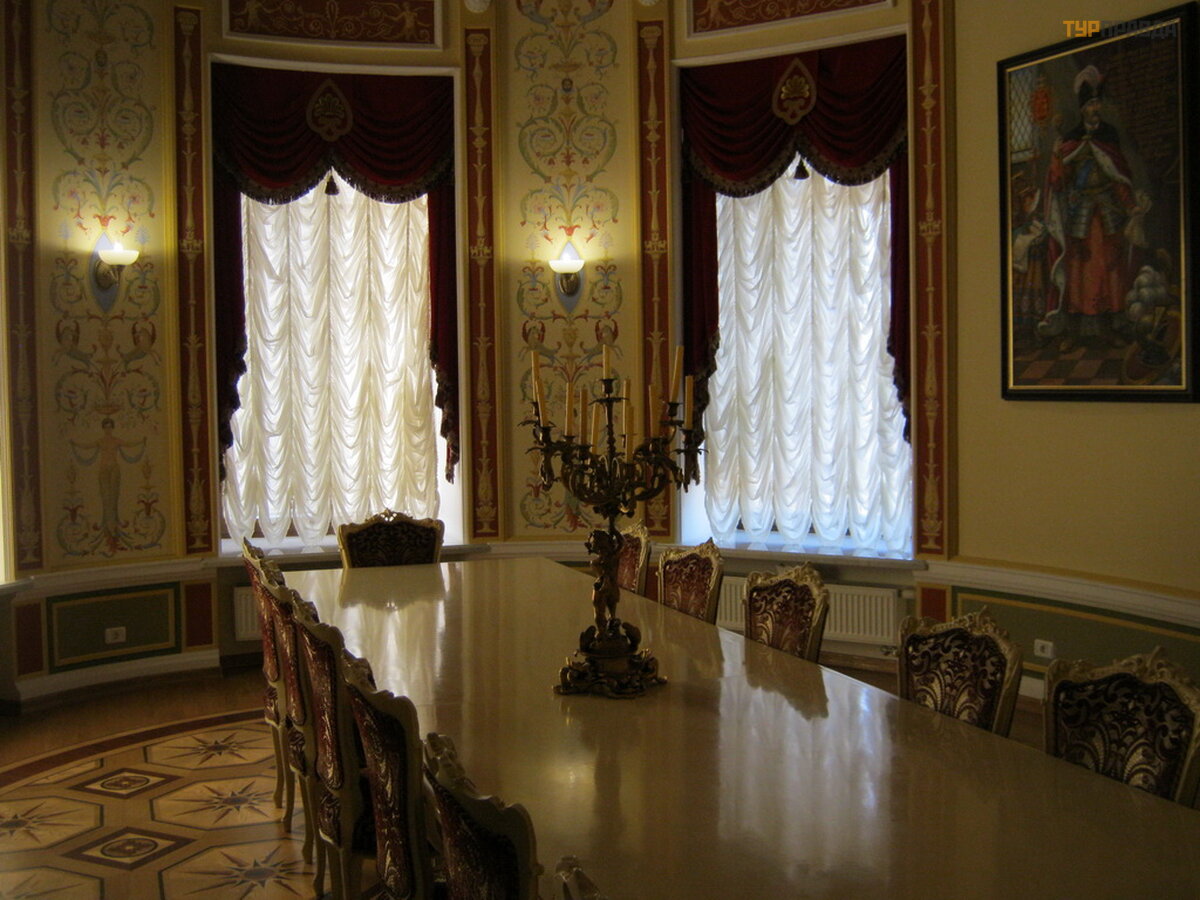 Table "Stone" in the Razumovsky Palace, Baturin
Table "Stone" in the Razumovsky Palace, Baturin
There is also a large collection of portraits of hetmans,
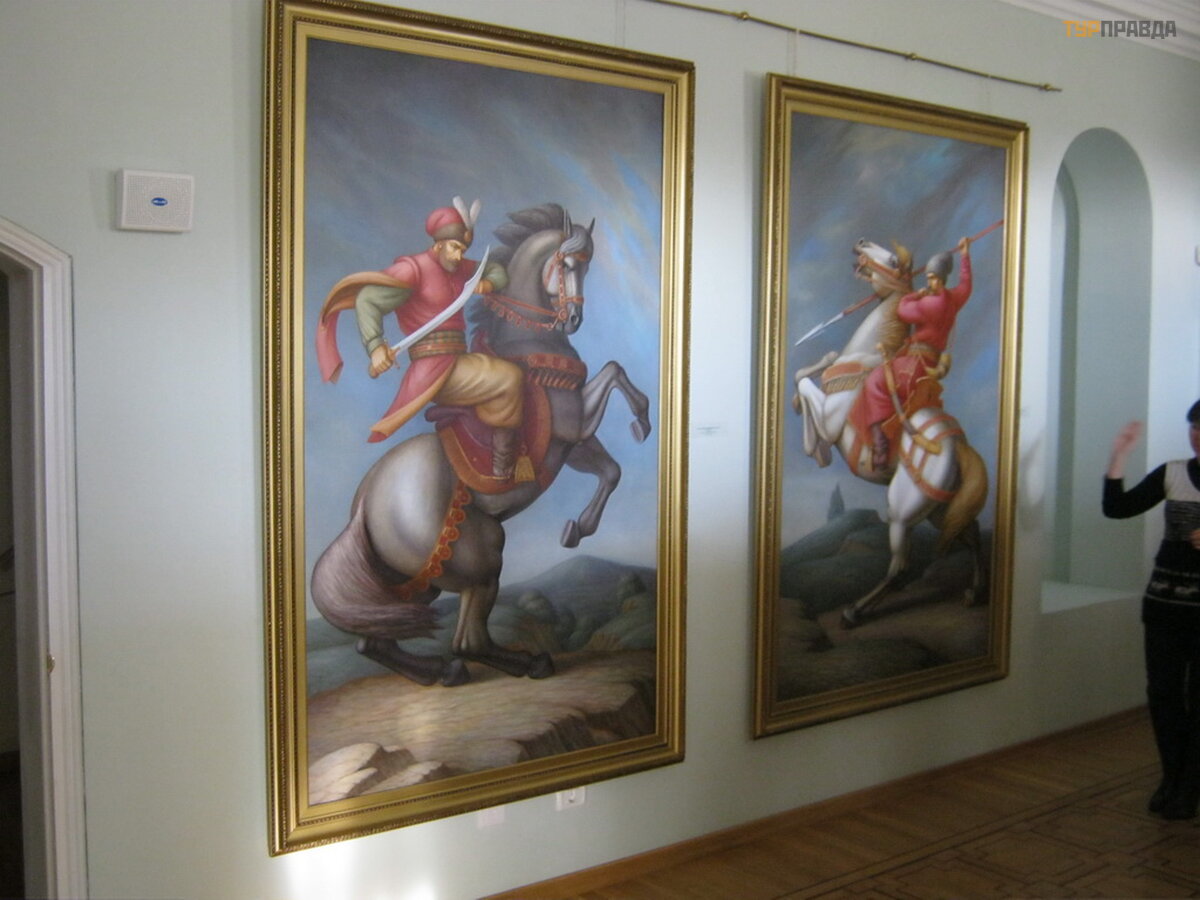 Collection of paintings in the Razumovsky Palace, Baturin
Collection of paintings in the Razumovsky Palace, Baturin
which were transferred to Baturyn from the Lviv Gallery. Also in the interior there is a house church,
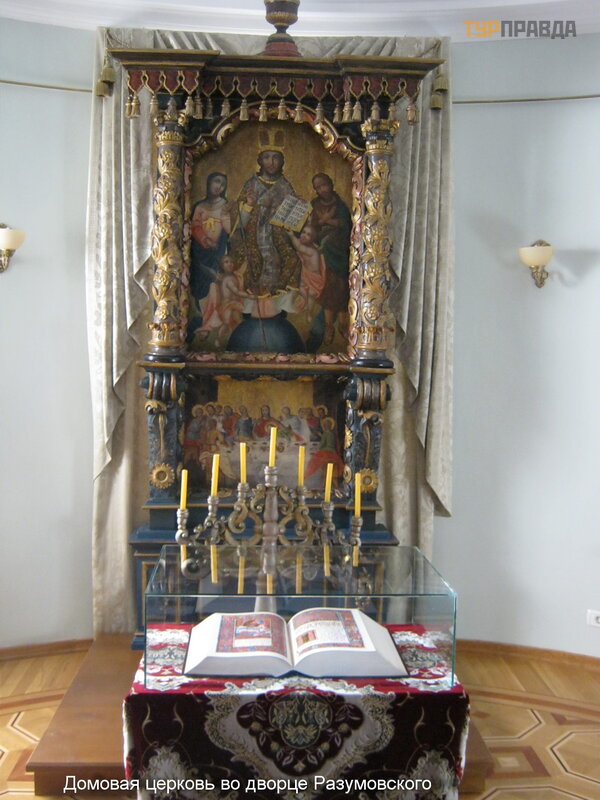 House church in the Razumovsky Palace, Baturin
House church in the Razumovsky Palace, Baturin
icons in which are also from Lviv.
Palace serves as an example of what can be made from durable ruins with proper financing, and after all, objects awaiting their restoration in Ukraine.
Now Baturyn is a city-museum. The facilities are scattered throughout the city. But you need to go there! Just to feel your identity, to know for sure who you are and where you come from.
a few words about the tour company "Openwork". So far, we have traveled with them only to Baturyn, although they offer a full range of excursions in Ukraine. We were satisfied with the tour. It’s inconvenient to go to Baturyn on your own - there is no direct connection from Kyiv, and somehow I don’t want to “kill” a car on our roads. In addition, it is always more interesting with a tour. The only “but”: when we paid for this trip, we were not warned at the company’s office that there were no stops near catering points under their program. So tourists take note - you need to take lunch with you. Well, we quickly bought delicious rye bread (they don’t bake this in big cities), had a bite and continued to “absorb” the guide’s story.
Travel around Ukraine! It's fun and affordable!
